Our Heat Pump Experience
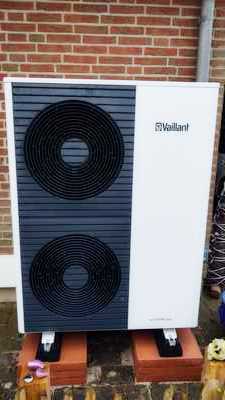
In 2021, we replaced the natural gas heating in our house with an air-source heat pump (ASHP) - without any further installations or renovation measures. So here what I learnt during the project. Heat pumps have the potential to become a central part of climate change mitigation and energy transition, since fossil fuels must disappear within 10 years if possible. They use electricity in the most efficient way, driven by sustainable sources if possible. With a growing amount of wind and solar power and rising carbon prices, heat pumps are likely to become the cheapest heating solution.
Mini-FAQ:
| one-off cost | $7.000$ - $20.000
(unit $4000 + $3000 installation with cheap models in the US.
In or case in Germany: 8000€ quality unit + water storage + installation + electric works = 20000€, 40% subsidized in Germany when replacing natural gas, for comparison: a new gas heating costs 8.000€ here + connection) |
|---|---|
| running cost | currently similar to gas, cheaper in the long run (1200€/year for our 150m2 house. With a decent carbon price and a large amount of sustainable electricity generation, heat pumps will soon gain advantage. Current market turbulences can accelerate the process. Unit life expectancy is shorter)
|
| In old buildings? | Yes. (some insulation is highly recommended though)
|
| Space consumption | similar to gas heating, additional external unit (weitere Umbauten im Haus nicht zwingend nötig)
|
Propeller boxes - what are they good for?
I always thought they were only used for air-conditioning. Often seen in Southern Europe, not so much here in the North. Do they blow air into the house? Of course not (see "basics"). A growing number of innovative homeowners has been using heat pumps since the millennium. In the early years, the models had their pitfalls, being noisy, often poorly adjusted, a money sink. It took me until 2019 that I realized what heat pumps really are and how they work.
A new gas heating? No way!
The investment decision was accelerated when an electrician accidentally chased 400 volts through the our wires after installing our PV system in November 2020: That killed freezer, tumble dryer, dishwasher, printer and several small devices. The gas heating continued working after exchanging the fuse. But the plumber spoke of a security risk. Electronics from 1997 was no longer available. So we needed a new heating system. Natural gas had always appeared to be reliant and efficient. With about 18,000 kWh heating energy per year and around 1000 euros heating costs in a 4-person household we could not sue. Within a week, a new gas system would have been installed. But it would be in operation until maybe 2050. Considering the devastating impact of climate change, no good idea. More about these thoughts down in the article.
Heat Pump Basics
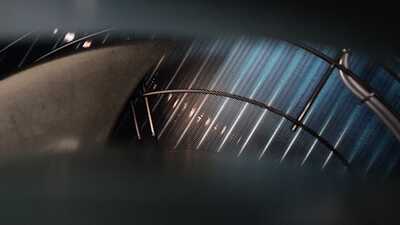
The rear grid resembles a fridge.
Like a fridge - just reverse
Heat pumps require electric power. But they multiply the energy: From 1 kWh electricity they gain 3 - 4 kWh heat. The trick: The heat pump uses the energy of the outside air. Even frosty air still contains energy. In order to increase the inside temperature e.g. from 5 to 20 degrees, a much larger volume of outside air can be cooled down from 5 to 0 degrees.
For this purpose, a special refrigerant flows over thin pipes in the circulation between the inner and outdoor unit back and forth. First, it absorbs the temperature of the outside air. Compressors press it together. It is getting hot. The heat brings over a heat exchange the heating and hot water in the house at temperature. Then the pressure is released. The refrigerant has lost energy, so now is colder than the outside air and can be warmed up again outside. Hard to believe, but true: Frosty air still contains enough energy to heat up a full tank of hot water up to 60°C (140°F).
Air source, water source or geothermal
<Air source heat pumps (ASHP) are the least complicated to install because air is always available. No surprise: For water source heat pumps you need flowing or large body of water. With geothermal or ground source heat pumps (GSHP) drilling down to 50 to 400 meters depth is needed. Both alternatives can achieve better efficiencies. However, installation is more complex and thus more expensive. For geothermal heat pumps, the risk is added that the soil around the tube cools down too much in the long term. Solutions with depths below 1 km minimize that risk. But is is not affordable for a single-house system. Less distributed are air to air heat pumps with a rather low efficiency that supply warm air in the house without heating water.
From 1 kWh electricity to 4 kWh heat
Some electricity is still required by the compressor, the pumps and the propeller. The relation of output to input energy is expressed in the Coefficient Of Performance (COP). Averaged over a year (terms are "energy efficiency ratio" = EER and seasonal energy efficiency ratio= SEER), a typical value for modern air source heat pumps is 4 (=400% efficiency) depending on the difference between outdoor temperatures and the required temperature within in the radiators. In mild conditions with 10°C (50°F), even values of 6 are possible. If hard frost dominates the winter at -10°C (14°F), efficiency decreases to a COP of 2.
Typical COPs
| outside temperature | flow temperature (heating system) | COP old building | flow temperature | COP new building |
|---|---|---|---|---|
| 13°C / 55°F | 35°C / 95°F | 4 | 25°C / 77°F | 6 |
| 5°C / 41°F | 45°C / 113°F | 3 | 28°C / 82°F | 5 |
| 0°C / 32°F | 50°C / 122°F | 2 | 31°C / 88°F | 4 |
| -10°C / 14°F | 60°C / 140°F | 1.3 | 35°C / 95°F | 3 |
| -20°C / -4°F | 70°C / 158°F | 1 | 40°C / 104°C | 2 |
This means: With cold outside temperatures electricity consumption increases disproportionately, driven by two factors: You need more heat for the house. At the same time the heat pump efficiency decreases. Most devices have a built-in heating element (COP=1) that can be activated when outside temperatures fall below -10°C (14°F).
Planning
A heat pump in an older building
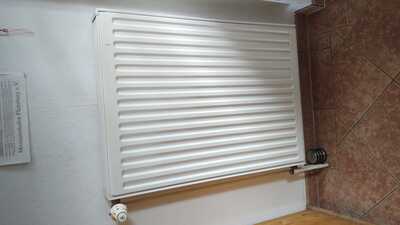
But it works: 30-35°C (86°-95°F) flow temperature is sufficient.
They work everywhere, but most efficient in insulated houses. That makes you the first choice for new buildings. In a floor heating the energy can radiate over large surfaces. Therefore, in new buildings, 35° C (95°F) flow temperature are sufficient, even if there is a frost outside.
Our house was built in 1997. The flow temperature is much higher for old buildings: 50 to 60°C (122-140°F) are required for old tube heaters in the worst case. For this reason, it is often advised to renovate first, exchanging radiators and improving the insulation of the building. We did not do that.
The crucial question was: Will the heat pump manage to get the house warm anyway at competitive costs? Only small areas of kitchen and bathrooms are provided with underfloor heating. The radiators are flat, but rather small dimensioned. At least, the house appeared to be well insulated. After the first winter days, our confidence was rewarded: at outdoor temperatures around the 0°C (32°F), we get along with a flow temperature of 40°C (104°F). And even with strict frost of -8°C (18°F), the house remains pleasantly warm at reasonable costs, although the heat pump activates an antifreeze mode over night. More below in the section to the consumption.
7 or 10 kW heating power?
In many forums I can read that a heat pump with high capacity would have disadvantages. This is an aspect if you first install the heat pump and postpone renovation. Larger heat pumps are more expensive and bulky. But in efficiency there are little differences. In one and the same situation, a large model will consume 3 kW electric power over 10 minutes and then pause for 20 minutes. The small model will continually consume 1 kW (both resulting in 3-4 kW heat) but already be on its limit.
A side aspect here in Germany: If you have photovoltaic on the roof, the calculation improves with every generated kWh that you consume yourself. You only get 8ct/kWh while if you feed-in, but you pay 30ct/kWh for the energy you buy (depending on installation dates and contracts). So even if you have 10 kWp installed on the roof, in many situations PV production will be around 1 kW. And thus, with a smaller heat pump you will be better off. However, regulations and electricity and feed-in tariffs differ much in other countries.
I have also heard that you diminish the heat pump's life time if it is oversized. They "modulate", going on and off all the time depending on the settings. But also small heat pumps modulate the most time of the year. I suppose it is difficult to find a definite answer to that.
Expensive heating element
When temperature falls below -8°C = 18°F (bivalence point), the electric resistor heating element can automatically be activated, depending on the settings. In this case, a 10 kW heat pump would temporarily consume full 10 kW of power resulting in 3€ per hour heating costs with out tariff. If you leave it off, the house will warm up less. At -8°C (18°F) this winter, our house had no problem to hold 19-20°C (66-68°F) without the heating element.
Avoid HFC refrigerants!
Only the most recent models use R290 (propane) with a very low climate impact.
But there are still many heat pumps offered with problematic refrigerants. The most common is the hydrofluorcarbon R410A (HFC-410A) with a global warming potential (GWP) of more than 2000. We were offered such a system, too. Typically only about 3kg are used. But if this slips into the atmosphere, the impact is similar to 6tCO2, which is about the amount of emissions from two years of natural gas heating. After a few years of operation, refrigerants must be filled up. From 2025, there are limitations in the EU for using some HFC based substances. There are substitutes like R32 which are a more flammable but still have a GWP over 600. Propane's GWP is only 3, also flammable but professional installers can handle that. Same as with natural gas.
| refrigerant | Global Warming Potential | If the refrigerant slips away, the climate impact of typical 3kg is like |
|---|---|---|
| R290 (propane) | 3 | 1 day natural gas heating |
| R32 | >600 | 200 days natural gas heating |
| R410A | >2000 | 2 years natural gas heating |
R290 was one of the main reasons to go for our Vaillant arothermPlus unit with 10 kW thermal power. Other German brands like Viessmann, Skadek, Teko and Wolf also offer R290. Choices among international manufacturers with R290 seemed to be very limited in 2021.
How much water storage?
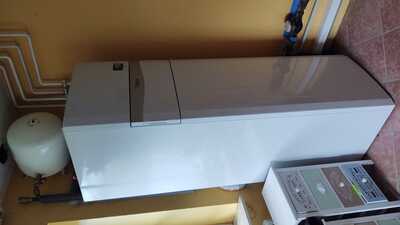
We took the 180 litre model, sufficient for a 4 person household, as log as not everyone takes long showers simultaneously. The alternative contained 300 litres.
A big storage would be an advantage in combination with hourly-flexible tariffs. By 2022, there are no competitive heat pump tariffs in Germany yet. But there is a potential and energy transition could well benefit from it. You heat up the storage when much PV or wind power is available - and the price per kWh is cheap. This avoids high loads in times of low availability. Another option is to feed the water storage when your own PV produces cheap energy. This can minimize the external demand to zero in summer when heating is only needed for hot water.
Where to place?
The potential noise emission was one of my biggest concerns. If your neighbourhood is sensitive this can cause a lot of trouble.
An advice: Check out the noise levels in a new housing estate on a cold day where heat pumps are common. We were surprised how quiet it was. Only a few models were perceivable within a radius of more than 20 metres. But what if the noise increases over the years?
You may consider a position with the least conflict potential. The plumber calculated his first offer including an underground tube of 10 metres for 600 €. He was confident that this would not cause any considerable energy loss. If performance drops down after a few years, trouble-shooting could become difficult with such a tube. In an attempt to keep things simple, the indoor and outdoor units are now places on either sides of the wall.
We lifted the unit by 20cm with some paving stones, in addition to the foot, to improve effifiency. It can be coldest on the ground, it prevents from snow, leaves and dirt blocking the unit. If possible, place it where sunrays can reach the unit. In our case it is the eastern side of the house - an advantage because our heat has to work hardest in the morning after being off in the night.
You should protect the heat pump to avoid collisions with cars. We chose wooden piles and a small fence, which is decorated seasonally.
Check out subsidy options in your country or state
In Germany installation costs are high. On the other hand you can apply for generous subsidies if you replace a gas (40%) or oil (50%) heating. Important: Apply before you start.
Cheap electricity tariffs for heat pumps
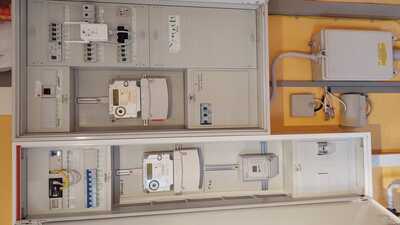
On the left the electricity meter including heat pump and BEV
On the right only the household including PV
A second electricity meter can be useful if you can benefit from reduced tariffs. In Germany, special tariffs are available for heat pumps and BEV (battery electric vehicle)-charging. Some providers allow to put both behind one electricity meter. This saves up to 0.08€/kWh. The catch: Providers can theoretically curtail delivery up to 2 hours per day if the electricity grid is overloaded. Practically that does not happen yet. In Germany has very high taxes and fees on the electricity price. What you pay for a kWh differs very much if you look at countries.
The first days in operation - a different approach to heating than we were used to
After 5 months of waiting for the installation, in September 2021 it finally began. It took 3 days for plumbers and electricians, including a hole in the wall. The first days it was mild outside, we only needed hot water. The experts left us with an inefficient configuration which I had to change. More under configuration.
Same temperature in every room - automatically regulated by the outdoor sensor

flow temperature on the left, outside temperature on the bottom in °C.
Out setting is 0.8. Source: Vaillant
With the gas heating, we used to turn radiators on and off only when needed. With the heat pump it is a different concept. It aims to distribute the energy evenly over the house. The outside temperature sensor alone determines flow temperature while all thermostats remain fully openend. For this purpose, a heating curve assigns a certain flow temperature (e.g., 35°C=95°F) to each outside temperature (e.g. 5°C=41°F) , depending on the house insulation and the desired internal temperature. Unfortunately the sensor does not record whether it is windy. On those days our house needs a bit more heating. But it is easy to increase the desired inside temperature temporarily for a selectable number of hours in the controller's menu.
Hydraulic balancing

In our case there is only one circuit of heating water. You can also work with multiple ones if you want separate regulations different parts / rooms of the house. But that would require additional installations. For each circuit it is recommended to balance the pressure in order to distribute the energy evenly. The flow close to the indoor unit will be attenuated.
We were also promised less flowing noise but we cannot really tell the difference. In Germany, hydraulic balancing is required if you apply for subsidies. It costs about 300€ extra.
You can still open and close any thermostat. But the heating water pump just stops when we close too many. And the more you close the louder it gets inside.
Fast airing, seals, thermal bridges
If you want efficiency with low flow temperatures, it just takes longer to heat up a room. You should avoid permanent cooling. Airing remains essential but keep it short. You should be aware that air contains only little thermal energy. You do not lose much energy if you only exchange the air. Walls and furniture contain much more thermal energy. If they cool down over a longer period of time your energy consumption will be much higher.
The consequence: never open or tilt the windows for more than 10 minutes during the heating season. Generally, it can be worth investigating where the house loses thermal energy. I had to constitute that the front door rubber seals leave gaps open. You can use special infrared cameras to detect the issues. Retail prices are between $200 and $1200.
Configuration
The controller SensoComfort only offers basic custom settings in the user's menu. The real important settings are in the expert's menu (for installers) which can be code protected. I suppose that happens for warranty reasons. However, we got access. Before you alter this configuration, it is important to know what you are doing.
Custom settings
Every user can set the aspired indoor and hot water temperature, compose operation schedules and read out information about electricity consumption (kWh for heating and hot water) as well as produced heat energy. I have created a LibreOffice Calc sheet to monitor efficiency. Vaillant offers a Simulator for the controller.
Installer settings
The protected configurations contain the heating curve, usage of the heating element, minimum and maximum flow temperature and much more. Even the information about the flow temperature can only be retrieved here. You can set from which outside temperature the heating is turned off (OT switch-off threshold), offsets for the hot water storage (flow temperature offset for heating it up and a threshold when heating starts). The reason for bad performance during the first days was a 25K offset for hot water. The heat pump had to generate 80°C (176°F) for the desired hot water temperature of 55°C (131°F). When I set it down to 5K, the COP instantly jumped from 2.5 to 4.
Silent mode
The silent mode reduces outside noise significantly from about 55 to 35 dB. According to the data sheet, efficiency remains the same. Maximum heating power and electricity consumption are reduced. Only during the winter we need full power. So the silent mode is the perfect setting for all other seasons, reducing noise, modulation and improving PV integration.
Off at night
Our heat pump remains off from 10pm to 9am. We like it quiet and not so warm while sleeping. Temperature falls from 21 to 19°C or 18°C (from 70 to 65°F) until the next morning depending on weather conditions. There are different opinions whether this is useful: The next morning the heating load is bigger. On the other hand, outside temperatures are lower at night, resulting in lower efficiency. So it can rather be an advantage.
Three schedules
You can choose different time spans for
- Heating
- Hot water
- Silent mode
Heating starts at 9am, hot water at 11am. There is still enough hot water in the storage for a few showers in the morning though. Generally, hot water has priority. But we want the heating to start first. When the water is warmed up at 11am, we can already use a decent amount of photovoltaics on most days.
frost protection

From 9am-10pm the heat pump was in almost constant operation with an electricity demand of 30 kWh.
Some peaks above 3 kW are other devices. The late consumption is BEV-charging.
Froist protection starts after 4 hours with less than 4°C (39°F). Even in the installer's menu you cannot change that. After contacting Vaillant, they wrote that only technicians with a laptop and special software could change that. However, other units have it in the menu.
The defrost process involves occasionally clouds of fog emerging from the outside unit. Don't get suprised.
In operation
Noise outside: detectable in standard mode
We now have a double propeller. In standard operation they produce a low frequency noise, which disappears after about 10-20 meters during the day in traffic noise and the noise of a wastewater pumping station. We have it relatively quiet, 1.5 km to the main road, 2 km to the highway. The propellers generate a moderate 100 Hz tone.
There is also a high twirl. I think people world hear it in the gardens and balconies nearby in the night when it is very quiet outside. But then the pump is off. If necessary, you can install a sound absorbing box around the heat pump for 300 to 3000 euros. The air flow should not suffer from this.
Silent mode is really silent.
Noise in the house: silent unit but you hear the flow
The unit is more silent than the gas heating was, which made some noise in the intervals of burning. You can neither detect anything from the outside unit inside the house.
Unfortunately the flow noise in the radiators has increased due to a more powerful circulation pump. Hydraulic balancing could not prevent this.
Energy consumption
Better than expected. From September to February 400% efficiency. For heating, this may even rise with lower outside temperatures in the spring. On the other hand, hot water (with lower efficiency) is the only task left in the summer.
Heating costs are dependent on the outside temperature.
| outside temp | electricity per day heating | electricity per day hot water |
|---|---|---|
| -8°C (18°F) | 40 kWh | 4.2 kWh |
| -4°C (25°F) | 30 kWh | 3.8 kWh |
| 0°C (32°F) | 20 kWh | 3.4 kWh |
| 4°C (39°F) | 10 kWh | 3.2 kWh |
| 8°C (46°F) | 5 kWh | 3 kWh |
| 12°C (54°F) | 2 kWh | 2.5 kWh |
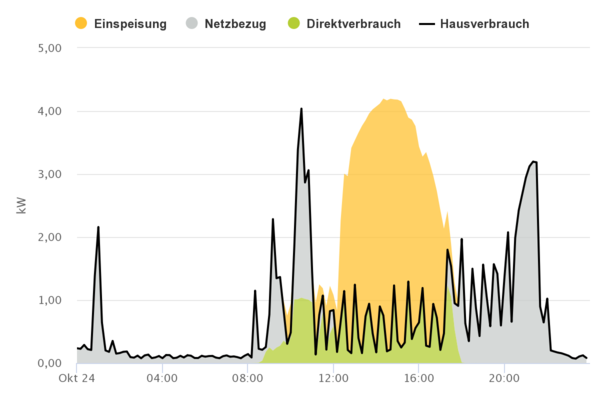
You can clearly see the heat pump working and pausing between 9am and 10pm.
It was a sunny day. PV production and heat pump demand are not synchronous though.
We use the opportunity to monitor the heat pump's operation via the PV's smart meter. You see the sum of all electricity consumption. But the heat pump can be assigned easily.
Only little contribution by photovoltaic
As expected, our 10 kWp PV without battery storage only delivers 20% of the required heat pump energy. In autumn and winter, with cloudy weather, it only produces 2 to 4 kWh over the whole day, while the heat pump consumes 15 to 20 kWh. In summer, it is the other way round: PV makes 50 kWh while the heat pump only needs 3 kWh for hot water. However, as described above, here in Germany we only get 8ct/kWh which we feed-in and we pay 24ct/kWh in our heat pump tariff for external load. Self-consumption pays off. Thus, a PV extension could be considered.
Alternatives: Why not natural gas?
It is forseeable that heat pumps become the cheapest and most climate friendly solution for domestic heating. They are based on electricity. In Germany, the government strives for a 80% of renewable energy in 2030. Whether this succeeds remains to be seen. But the direction is clear.
The share has already reached 50%. Here in North Germany it is even higher. Sceptics may argue that in the most current situations, every additional load - like our heat pump - triggers additional fossil electric production. That's true. But even if you have 100% fossil electricity, using the heat pump is still more climate friendly than burning natural gas at home. The key is the 400% efficiency of the heat pump. Combined with 30-40% efficiency in gas or coal power plants you still have 120-150% efficiency. Burning natural gas at home will never exceed 100% efficiency. The only thing that could spoil this calculation is the electric heating element. Make sure it is off by default in the configuration.
With more renewable energy, the electricity price will stabilize or even fall, while natural gas continues to rise, driven by CO2 pricing (independent from current record peaks in the market).
A factor of uncertainty remains with maintenance and repair costs. I read of a life expectancy of 15 to 20 years which would be less than our gas heating. The compressor alone is designed for up to 30 years. But at least the costs for the obligatory chimney drop out.
It is also possible to produce hydrogen and gas (methane) from wind and solar energy. But there are huge conversion losses. So that will remain expensive. Large scale production of green hydrogen is not expected before the late 2030s. Industry, planes and ships will need it first. In order to fill the gas grid with green methane, you would need huge quantities that are hardly ready before 2040 or 2050. A multiple of wind and PV parks would have to be installed for that purpose. We already hear that green hydrogen imports will remain necessary for a long time.
District heating
District heating was always considered to be efficient and environmentally friendly. When burning coal or gas for electricity production, a lot of heat is produced. Usually wasted. But you can use it for heating a whole city. However, if gas or coal is burned, this produces CO2. Accordingly, all city utilities sit in the price trap.
Some day, district heating systems can also be fed by large scale seawater heat pumps or geothermal energy. It could also make sense to use the waste heat of electrolysers or hydrogen retraction for district heating grids. Hydrogen could be a seasonal storage medium to overcome time spans without wind and sun in the winter. When electrolysers and green hydrogen generators are combined with district heating, efficiency improves. But it will take several years until systems are ready. In this respect, conventional district heating power plants still heat up the climate in these crucial years.
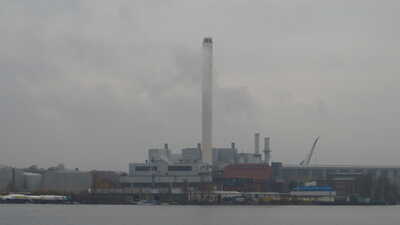
It works efficiently, but far from being climate neutral.
Low-carbon district heating with biomass
In our village, district heating is now offered with a progressive concept: A small power plant burns waste wood from regional forestry in combination with biogas. This is advertised as CO2-free because the trees have withdrawn the CO2 of the atmosphere, being released at the time of combustion. Of course, the this is not climate neutral as long as diesel vehicles move the wood. Even if transport was electric at some point, one question remains: What would happen if you would not burn the wood? This would delay the CO2 release by a few years. These years are very crucial. Sound like I'm looking for the fly in the ointment, I know.
However, this cannot be a solution on a large scale. Some companies are already promoting to replace coal in power plants with wood. But the local quantities cannot feed the demand.
The story continues...
Thank you for reading. From time to time I will add some updates.Author: Peer-Axel Kroeske (Mail / Homepage)
globalenergyconcept.org
